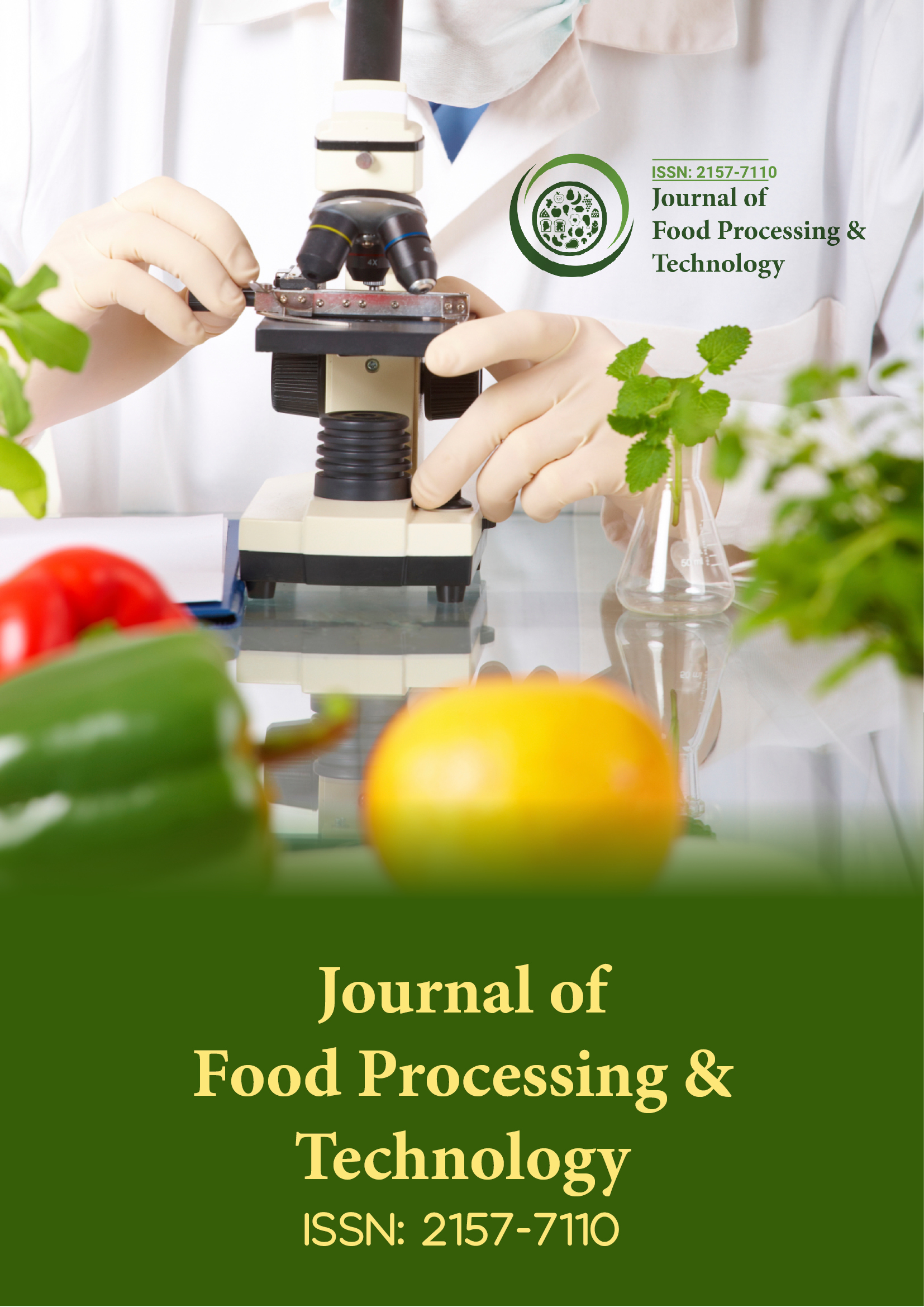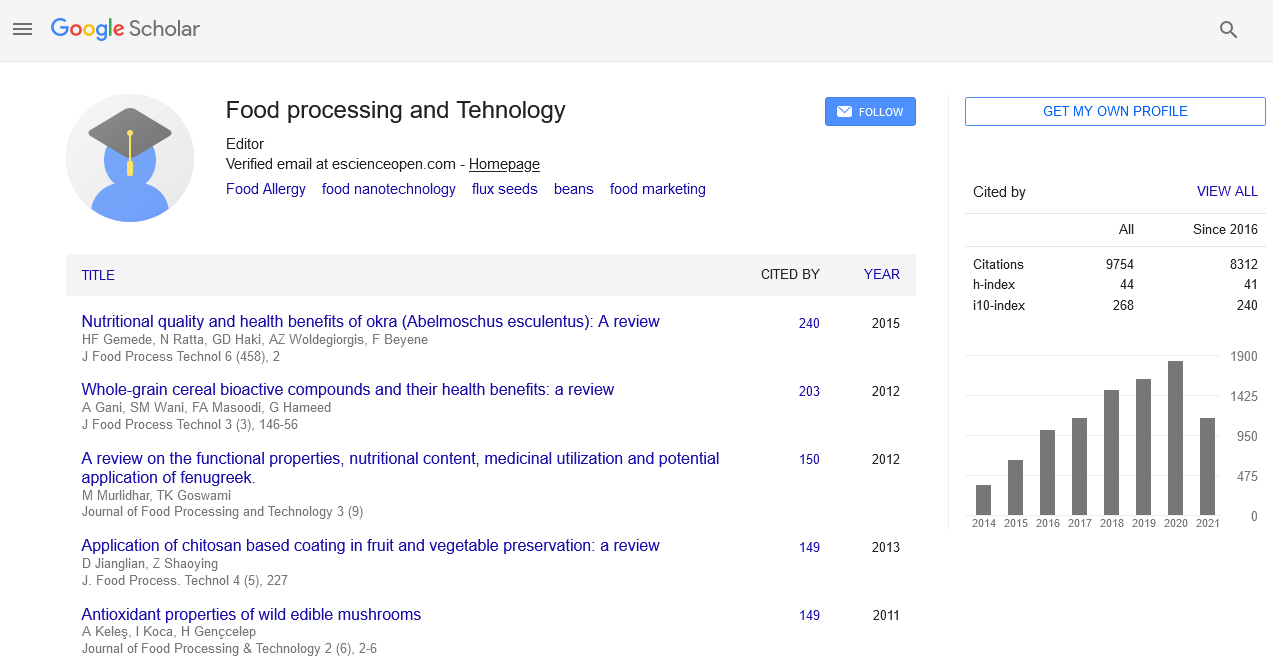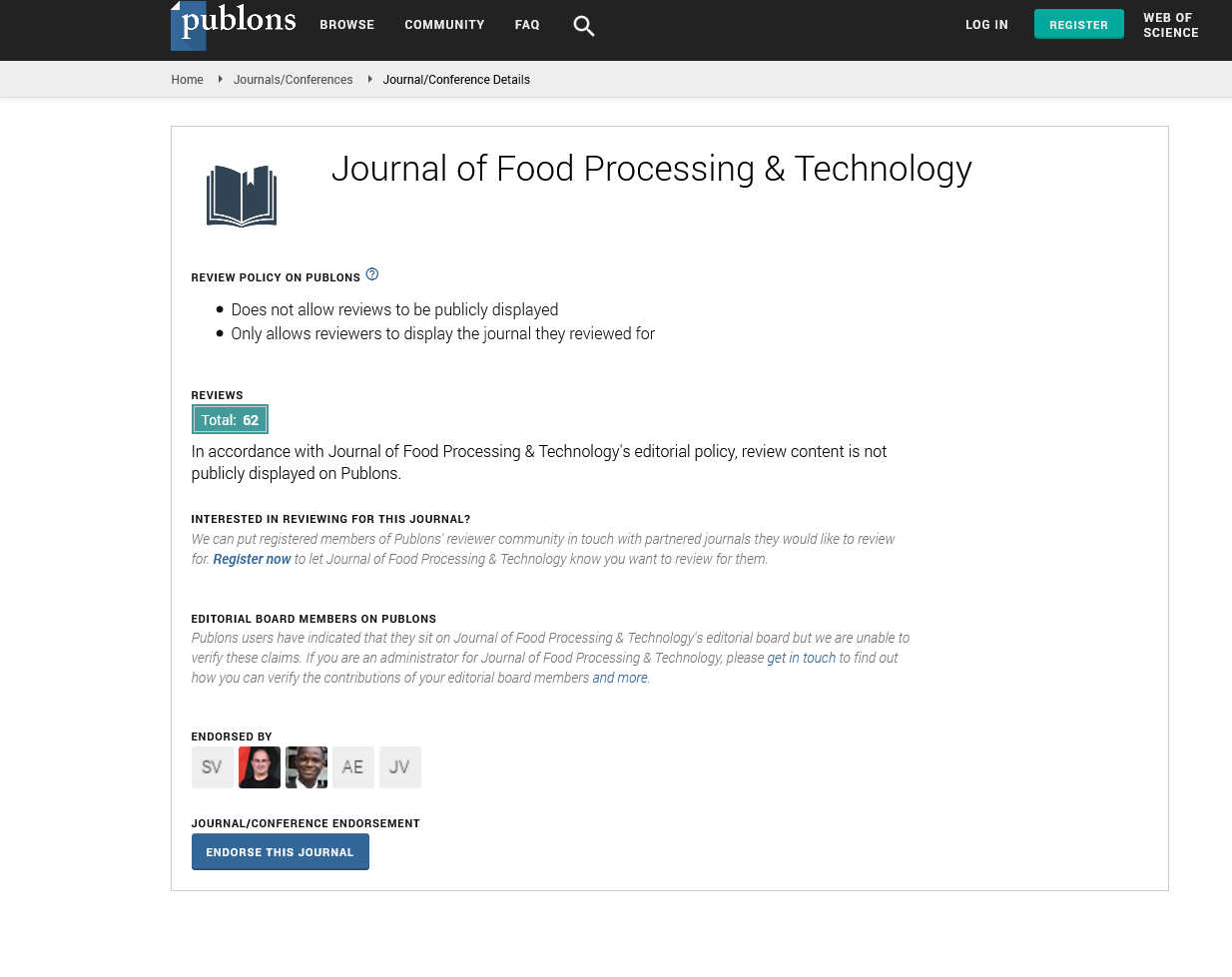Indexed In
- Genamics JournalSeek
- Academic Keys
- JournalTOCs
- China National Knowledge Infrastructure (CNKI)
- Access to Global Online Research in Agriculture (AGORA)
- Centre for Agriculture and Biosciences International (CABI)
- RefSeek
- Directory of Research Journal Indexing (DRJI)
- Hamdard University
- EBSCO A-Z
- OCLC- WorldCat
- Scholarsteer
- SWB online catalog
- Publons
- Euro Pub
- Google Scholar
Useful Links
Share This Page
Journal Flyer

Open Access Journals
- Agri and Aquaculture
- Biochemistry
- Bioinformatics & Systems Biology
- Business & Management
- Chemistry
- Clinical Sciences
- Engineering
- Food & Nutrition
- General Science
- Genetics & Molecular Biology
- Immunology & Microbiology
- Medical Sciences
- Neuroscience & Psychology
- Nursing & Health Care
- Pharmaceutical Sciences
Commentary - (2025) Volume 16, Issue 3
Cold Plasma Technology for Enhancing Food Safety Without Heat Treatment
Oliver Weber*Received: 26-May-2025, Manuscript No. JFPT-25-29650; Editor assigned: 28-May-2025, Pre QC No. JFPT-25-29650; Reviewed: 11-Jun-2025, QC No. JFPT-25-29650; Revised: 19-Jun-2025, Manuscript No. JFPT-25-29650; Published: 25-Jun-2025, DOI: 10.35248/2157-7110.25.16.1166
Description
Cold plasma technology has recently emerged as a promising and innovative tool for enhancing food safety, offering effective microbial inactivation without relying on high-temperature treatments. This characteristic makes it particularly valuable for processing foods that are sensitive to heat, including fresh fruits and vegetables, ready-to-eat meals, juices, dairy products, and minimally processed foods. Traditional thermal pasteurization and sterilization methods, while effective at controlling microbial contamination, often compromise the sensory and nutritional qualities of heat-sensitive foods. Cold plasma offers a nonthermal alternative, preserving flavor, color, texture, and bioactive compounds, making it an attractive option for modern food processing.
Cold plasma is generated when an electric field or electromagnetic energy energizes a gas, typically air, oxygen, nitrogen, or noble gases such as helium or argon. This energy input ionizes the gas, producing a mixture of reactive species, including electrons, ions, radicals, and ultraviolet photons. These reactive particles interact with microbial cell membranes, proteins, and nucleic acids, causing structural damage and leading to cell death. The antimicrobial mechanism of cold plasma is multifaceted, combining oxidative stress, membrane disruption, and DNA damage, which ensures effective inactivation of a wide range of microorganisms. Unlike conventional heat-based methods, cold plasma leaves the food matrix relatively unchanged, preserving the sensory, nutritional, and functional properties of the product.
Research has demonstrated that cold plasma is effective against a broad spectrum of microorganisms, including pathogenic bacteria such as Salmonella, Listeria monocytogenes, Escherichia coli, and Bacillus species, as well as spoilage fungi, molds, and certain viruses. This broad antimicrobial activity positions cold plasma as a versatile tool for improving food safety across multiple sectors of the food industry. Additionally, the technology is highly efficient in terms of processing time; microbial inactivation can often be achieved in seconds to minutes, reducing energy consumption and processing costs relative to traditional methods. This rapid processing capability is particularly advantageous for high-throughput food production environments.
Beyond microbial inactivation, cold plasma offers several additional benefits that extend its applicability in food processing. Studies have reported that cold plasma treatment can enhance seed germination and growth by modifying seed surface properties and stimulating metabolic activity. In food applications, it has been observed to improve surface wettability and adhesion properties of fruits and vegetables, which can enhance the efficacy of subsequent coatings, edible films, or sanitizing treatments. Cold plasma has also been explored for its ability to degrade pesticide residues on fresh produce, contributing to safer and cleaner foods. The generation of reactive oxygen and nitrogen species during treatment can break down chemical contaminants, offering a dual benefit of microbial and chemical decontamination.
Despite its advantages, several challenges remain in scaling up cold plasma technology for industrial food processing. Ensuring uniform treatment across complex product surfaces, optimizing exposure times, and selecting appropriate gas compositions are critical for achieving consistent microbial inactivation. Equipment design and configuration, including dielectric barrier discharge systems, plasma jets, and plasma chambers, must be tailored to accommodate diverse food types and production volumes. Researchers are actively investigating these parameters to develop scalable, efficient, and reproducible systems suitable for commercial use.
Regulatory approval and consumer acceptance also play important roles in the widespread adoption of cold plasma technology. While it has been recognized as safe for certain applications, regulatory frameworks in different regions require comprehensive evaluation of its effects on food quality, nutritional content, and potential chemical byproducts. Transparent communication about the technology and its safety benefits is essential to build consumer trust and encourage uptake in commercial products.
Cold plasma technology represents a forward-looking approach in food safety, combining high antimicrobial efficacy with minimal impact on food quality. Its ability to inactivate a broad spectrum of pathogens, degrade pesticide residues, enhance seed performance, and modify surface properties highlights its versatility and potential as a multi-functional processing tool. As research continues to optimize processing parameters, improve equipment design, and validate safety outcomes, cold plasma is expected to become increasingly integrated into industrial food production systems. Its adoption aligns with the growing consumer demand for minimally processed, fresh-like, and safe foods, positioning cold plasma as a key technology for the next generation of sustainable and high-quality food processing solutions.
In conclusion, cold plasma offers a transformative opportunity for the food industry by providing a non-thermal, efficient, and versatile method to enhance safety and quality. As technological advancements and regulatory approvals progress, cold plasma has the potential to revolutionize the processing of fresh produce, ready-to-eat foods, and other heat-sensitive products, contributing to safer, healthier, and more appealing food options for consumers worldwide.
Citation: Weber O (2025). Cold Plasma Technology for Enhancing Food Safety Without Heat Treatment. J Food Process Technol.16: 1166.
Copyright: © 2025 Weber O. This is an open access article distributed under the terms of the Creative Commons Attribution License, which permits unrestricted use, distribution and reproduction in any medium, provided the original author and source are credited.


